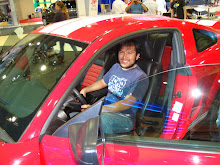Wednesday, April 28, 2010
Seat Belt
Most seat belts are equipped with locking mechanisms (or inertia reels) that tighten the belt when pulled fast (e.g. by the quick force of a passenger's body during a crash) but do not tighten when pulled slowly. This is implemented with a centrifugal clutch, which engages as the reel spins quickly. Alternatively, this function may be secured by a weighted pendulum or ball bearing: when these are deflected by deceleration or roll-over they lock into pawls on the reel.
In North America, cars sold since the early 1970s have included an audiovisual reminder system consisting of a light on the dashboard and a buzzer or chime reminding the driver and passengers to fasten their belts. Originally, these lights were accompanied by a warning buzzer whenever the transmission was in any position except park if either the driver was not buckled up or, as determined by a pressure sensor in the passenger's seat, if there was a passenger there not buckled up. However, this was considered by many to be a major annoyance, as the light would be on and the buzzer would sound continuously if front-seat passengers were not buckled up. Therefore, people who did not wish to buckle up would defeat this system by fastening the seatbelts with the seat empty and leaving them that way.
By the mid-1970s, auto manufacturers modified the system so that a warning buzzer would sound for several seconds before turning off (with the warning light), regardless of whether the car was started. However, if the driver was buckled up, the light would appear, but with no buzzer. New cars sold in the United States in 1974 and the first part of the 1975 model year were sold with a special "ignition interlock", whereby the driver could not start the car until the seat belt was fastened; however, this system was short-lived.
Today, the belt warning light may stay on for several minutes after the car is started if the driver's seat belt is not fastened.
In Europe and some other parts of the world, most modern cars include a seat-belt reminder light for the driver and some also include a reminder for the passenger, when present, activated by a pressure sensor under the passenger seat. A Swedish study showed that of the cars with seat belt reminder 8 of 10 drivers not using the seat belts were driving an Audi.
Some cars will intermittently flash the reminder light and sound the chime until the driver (and sometimes the front passenger, if present) fasten their seatbelts, and they sometimes even lock the speed to 10 km/h or less.
Sunday, April 4, 2010
DAVE MUSTAINE ANNOUNCES RETURN OF FOUNDING BASSIST DAVID ELLEFSON TO MEGADETH LINE-UP

Megadeth founder and frontman Dave Mustaine has announced the return of original bassist David Ellefson (1983-2002) to the iconic multi-platinum group. This reunion is appropriately timed to Megadeth's upcoming historic month-long Rust In Peace 20th anniversary tour which launches March 1 in Spokane, WA. At these incredibly special shows, Megadeth will play their landmark, genre-defining 1990 album Rust In Peace in its entirety, in addition to other Megadeth favorites.
"This shows the power of brotherly love and forgiveness," Mustaine says. "David Ellefson belongs in Megadeth. Next we are going to show you the power of getting your asses kicked...HARD!"
David Ellefson concurs: "This is a huge moment for all of us, band and fans alike. It is a great celebration of the music from one of the biggest landmark albums of our career."
Ellefson will join Mustaine and Megadeth band members Shawn Drover (drums) and Chris Broderick (guitar) on tour in support of the group's current CD Endgame, which has received some of the highest critical accolades of the band's career.
"We'd like to thank James LoMenzo for several years of loyal service on the bass, and wish him the very best," Mustaine adds.
For more information go to: www.megadeth.com.
Sunday, February 28, 2010
OZZY OSBOURNE Wins Round 1 Against TONY IOMMI in BLACK SABBATH Name Dispute closing ceremony
The Manhattan federal court suit also charges that Osbourne's "signature lead vocals" are largely responsible for the band's "extraordinary success," noting that its popularity plummeted during his absence from 1980 through 1996. Lawyer Andrew DeVore argued yesterday that Osbourne signed away all his rights to the BLACK SABBATH trademark after he quit the band in 1979.
Osbourne's lawyer, Howard Shire, called that agreement a "red herring" that was "repudiated" when the singer rejoined in 1997 and took over "quality control" of the band's merchandise, tours and recordings. In a statement released on May 29, 2009, Ozzy said about his decision to sue Iommi, "It is with great regret that I had to resort
See entire article in : http://www.roadrunnerrecords.com/BLABBERMOUTH.net/news.aspx?mode=Article&newsitemID=135789

